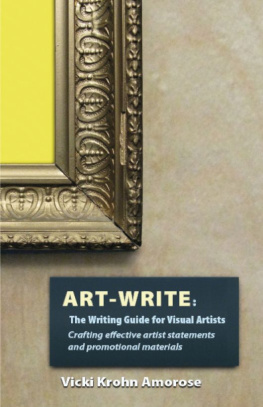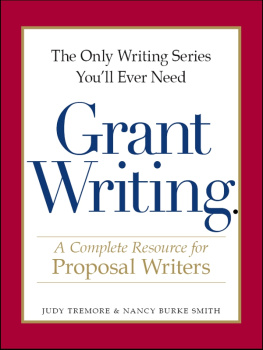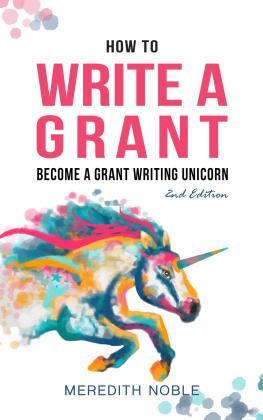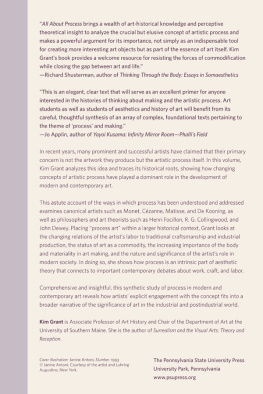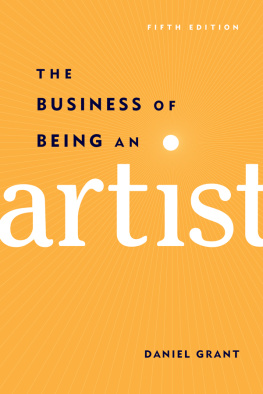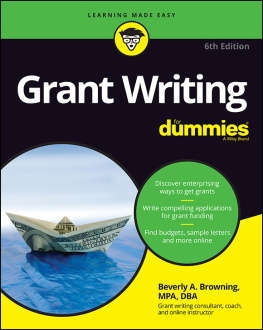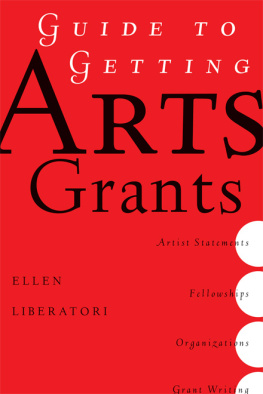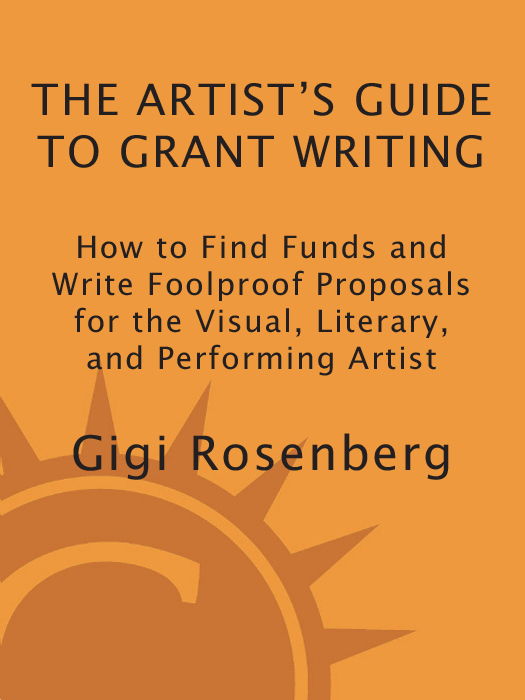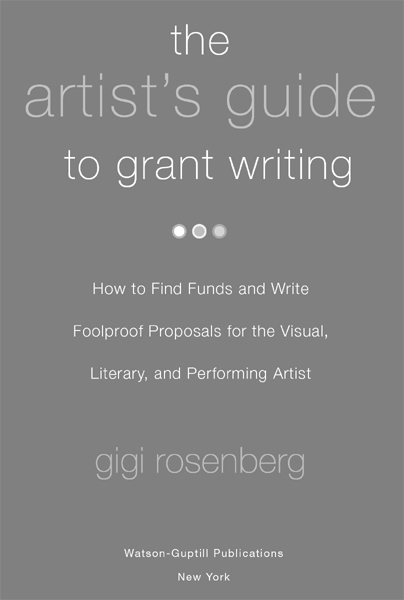Copyright 2010 by Gigi Rosenberg
All rights reserved.
Published in the United States by Watson-Guptill Publications, an imprint of the Crown Publishing Group, a division of Random House, Inc., New York.
www.crownpublishing.com
www.watsonguptill.com
WATSON-GUPTILL is a registered trademark and the WG and Horse designs are trademarks of Random House, Inc.
Library of Congress Cataloging-in-Publication Data
Rosenberg, Gigi.
The artists guide to grant writing : how to find funds and write foolproof proposals for the visual, literary, and performing artist / Gigi Rosenberg.
p. cm.
eISBN: 978-0-8230-2722-4
1. ArtsUnited StatesFinance. 2. Arts fund raisingUnited States. 3. Proposal writing for grantsUnited States. I. Title. II. Title: How to find funds and write foolproof proposals for the visual, literary, and performing artist.
NX705.5.U6R67 2010
700.79dc22
2010034585
v3.1_r2
To my parents,
all three of them:
Lilli Ann Killen Rosenberg
Robert Shore
Marvin Rosenberg
T his book would not have come to be without the encouragement and wisdom of Michael Broide; Sophie Broide; Ariel Gore; my editors, Carrie Cantor and Amy Vinchesi; and my agent, Rita Rosenkranz. I am also grateful for the guidance of editorial director Victoria Craven.
Many colleagues read and commented on early drafts. Much appreciation to Judith Aftergut; Pam Summa; and everyone in my Tuesday-night writing group, especially Kerry Cohen, Michael Guerra, Ken Olsen, Katie Schneider, Jeffrey Selin, and Ellen Urbani.
For crucial help along the way, Im grateful to Christina Katz; Vicki Lind and everyone in her Job Club, especially Jill Kelly, Donna Matrazzo, and Nick Thomas; Melissa Potter; Ben Killen Rosenberg; Evan Shore; Claire Vanderzwan; and Morrie Warshawski.
Many artists and grant specialists generously gave hours of their time in interviews with me and donated their writing for examples in this book. Unfortunately, not all of their stories made the final cut. For sharing their work, many thanks to Karen Atkinson, Linda Austin, Justine Avera, Mira Bartk, Jackie Battenfield, Leo Berk, Christa Blatchford, Helen Borten, Tracy Broyles, Sage Cohen, Bonnie Collura, Helen Daltoso, Marc Dennis, Sean Elwood, Bret Fetzer, Joan Findlay, Helen Hiebert, Linda Hutchins, Kemi Ilesanmi, Gretchin Lair, Aaron Landsman, Jon Lapointe, James Lapp, John Jota Leaos, Ken May, Caroll Michels, Monica Miller, Christopher Mooney, Licia Perea, Shannon Planchon, Aviva Rahmani, Rita Robillard, Ethan Rose, Dread Scott, Mark R. Smith, Kim Stafford, Cheryl Strayed, Phil Sylvester, Mary Szybist, George Taylor, Juana Valdes, and especially Grace Weston.
Heather Darcy Bhandari, Janet Bloch, Cindy Hudson, Nancy Hytone Leb, Leanne Palmer, Jen Rountree, Judith Teitelman, Ellen Thomas, and especially Eva Schweber provided key assistance during research or at workshops.
Thanks to the staffs at Creative Capital, Foundation Center, New York Foundation for the Arts, South Carolina Arts Commission, and Urban Institute for answering many research questions. My research was also informed by Judith B. Margolins 1983 book The Individuals Guide to Grants, the first to focus on the courageous individual grant seeker.
Finally, thanks to you, the writers and artists who clamored for more and motivated me to write it all down.
Grant writing jump-starts
a conversation between you
and your art and
your art and the world.
I landed my first grant as the result of a verbal pitch. It was a rainy day in August 1972 in South Wellfleet, Massachusetts. Im bored, I said to my parents. I wanna make a film. Ill put them in it. I pointed to my younger brother and sister. Can you give me the money to buy a couple rolls of Super 8 Kodachrome and loan me your tripod? My parents agreed on one condition. Dont fight with your brother and sister, my mother said. My stepfather handed me the cash. I was fourteen years old.
Three weeks later, as Crazy 500 flickered to life in our darkened living room, the first animated credit read, This film made possible with a grant from the Marvin and Lilli Ann Killen Rosenberg Foundation. I didnt realize then how much I already knew about funding artistic projects. I had matched the needs of my financial backers, assembled a team I knew would impress them, explained exactly how Id spend their money, and designed a project they found irresistible. I even remembered to thank them prominently at the premier. And I made the film without any artistic compromises except for one annoyance: My sister refused to change out of her pajamas for the shoot or even wear the same nightgown each day for the sake of continuity.
By the time I reached my twenties and started applying for grants in the real world, Id forgotten all I knew. Instead of building on my good instincts, I floundered. I felt like I was standing on one side of a brick wall without a clue how to catapult myself over to the pot of money Id heard was on the other side.
The first grant I wrote was to the Boston Film and Video Foundation asking them to fund a documentary film. Id met a seventy-three-year-old Tennessee woman on a business trip who turned out to have been my grandfathers mistress for four years in the 1930s. She credited my grandfather with helping her go from a spinner in a textile mill earning $4 per week to a Southern labor leader. By a twist of fate, Id found her.
I didnt show my application to anyone. I treated it like a top-secret communiqu between me and the foundation. In my studio apartment, when my scientist boyfriend wasnt around, I edited my work samplea short video consisting of interviews Id done, historic photos Id collected, and footage Id shot on my visits to Tennessee. The narration was my own shaky voice.
The process of answering the questions on the grant application, assembling my work sample, and calculating a budget was agonizing and filled me with an odd shame. I was afraid to commit my plans to paper, and this fear turned into resentment at having to explain myself. I wanted to be a filmmaker, I wanted the money to make a project, but I didnt want to have to ask for it in black and white. Why wont they just give it to me? Why do I have to justify it?
Something deeper was going on that I couldnt see at the time. I wanted to be chosen. I wanted this foundation to tell me I was a filmmaker so I could feel like one. I wanted permission.
Both of my parents were professional artists. My mother made one hundred-foot-long mosaic murals in our basement. At our house, if you could make it, you didnt buy it. On my grandmothers black-and-gold sewing machine, I stitched outfits for my Barbie dolls and then clothes for myself to wear to school. I developed photographs in our darkroom and built clay sculptures in my mothers pottery studio.



